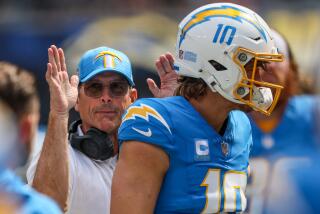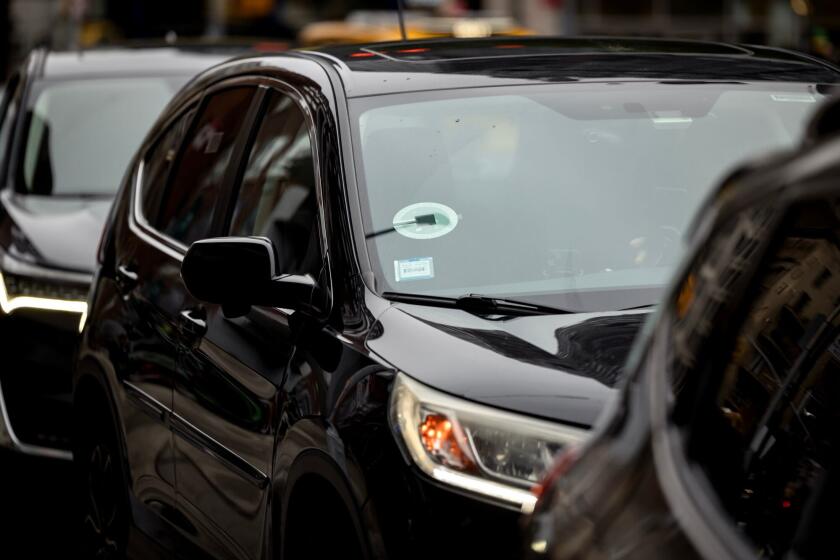Back From Repair, U.S. Auto Makers Rev in Tune
- Share via
Sending a confident signal in a time of economic worry, car and truck sales have been rising smartly all year--especially U.S. automotive sales and particularly Chrysler sales.
Domestic car makers are taking back market share from imports as vehicle sales by U.S. companies rose an average 14% through mid-September--with Chrysler sales ahead 26%.
Earnings are rising and the stock market has noticed: Ford and Chrysler stocks hit all time highs last week. Even General Motors--facing tough labor talks and contemplating paying early retirement or severance to 50,000 more workers--rose as well. Suppliers to the auto industry too enjoy high stock prices--Dana, Eaton, Rockwell, A.O. Smith and others.
More than a market rally is involved. The success of U.S. car makers, especially Chrysler, results from their recognition of new realities in the world automotive industry--that cars aren’t cornflakes, so a company doesn’t have to be massive; that the public’s taste for luxury has shifted.
Success results also from the renewed strength of U.S. manufacturing, which remains an unheralded phenomenon.
The U.S. car industry is in its best shape in over a decade thanks to years of computerizing factories, rearranging work and cutting or retiring workers. Labor has adjusted; the United Auto Workers union has just signed a contract with Ford and is now negotiating with Chrysler. Settlements at both will be similar--3% pay raises and a hike in pension benefits among other points. Chrysler’s costs will still be low enough for it to bring out the Neon, a new U.S.-built small car, in January and sell it profitably for $8,600.
“The Neon will be profitable,” says Chrysler Chairman Robert Eaton. Until now, U.S. car makers have lost money on small cars. But the Neon, 87% of it built in Belvidere, Ill., and other U.S. plants, will make a profit because Chrysler--which has come close to bankruptcy twice since 1980--got teamwork, efficiency and speed from workers, managers, engineers and accountants.
All this while the rest of the world wakes up to the competitive dilemmas that faced U.S. companies in the early ‘80s. In Germany, Volkswagen finds its costs woefully uncompetitive and starts restructuring; the maker of Mercedes-Benz does likewise and plans to manufacture in the United States to be competitive. In France, Renault merges with Sweden’s Volvo to gain size and supposed strength. In Japan, Nissan is losing money and closing plants, Honda is restructuring, and Toyota, say experts, is big, overstaffed and a sitting duck.
Meanwhile Chrysler, which for years sought global partners in Mitsubishi and Fiat, now wants to remain on its own. “A roughly 2 million vehicle company--we’ll produce about 2.3 million this year--is an excellent size,” says Eaton, 53, an engineer from the University of Kansas who rose to the presidency of General Motors Europe before coming to Chrysler in 1992.
“The reason for that is the fractionation in the market--nobody produces plan after plan of the same car. So our size gives us flexibility; we don’t have a big bureaucracy like Toyota or GM.”
Analyst Maryann Keller of Furman Selz Mager Dietz & Birney, an investment firm, explains fractionation another way. “Everywhere in the world, cornflakes are the same, but cars are different because tastes and conditions differ.” So aiming for a single, global company doesn’t make as much sense in cars as it does in breakfast cereal.
And that is even more the case today when tastes are changing, says Keller, who has just published a new book, titled “Collision,” on the auto industry of the 21st Century.
More than any other car maker, Chrysler has caught this shift in taste with its variety of minivans, Jeeps and new upscale cars, the Chrysler Concorde, Dodge Intrepid and Eagle Vision. Call it undeclared, or even disguised, luxury. Customers are buying minivans and Jeep Grand Cherokees these days with leather upholstery, CD players and every other convenience. Such is fashion that a loaded Jeep is rugged individualism but a Mercedes S Class mere indulgence.
The rewards of fashion are substantial. Chrysler earns double the rate of profit on minivans and Jeeps that other companies make on traditional cars. The new Chrysler cars, offering aspiring luxury at about $21,000 apiece, are highly profitable as well.
That’s fortunate because Chrysler, which still bears the scars of a second near demise in 1991, needs the money. The company must pay down debt, put billions into its pension fund and build up cash. Eaton’s goal is to return Chrysler to full financial health within two years.
And he is confident: “If the economy doesn’t go against us, we can repair our balance sheet and withstand the next recession as a financially strong, independent company.”
Analyst Joseph Phillippi of Lehman Bros. thinks Chrysler will succeed and other U.S. auto makers will continue to do well. “It’s a good economy for them, sales are growing but not so much to strain capacity,” he says.
Other businesses, struggling to make a buck in a slow recovery, should take note. U.S. auto makers and other manufacturers endured a decade of painful reform but can now make good profits on a small upturn--just as individuals living within their means can benefit from a small pay raise.
Another lesson is that being hungry doesn’t hurt. Chrysler acquired the failing American Motors in 1987, gaining not only the Jeep but a bunch of American Motors executives who were used to getting the most out of every scarce dollar.
One of them, Francois Castaing, is Chrysler’s chief of engineering today and had key responsibility for developing the Neon. It’s no accident that Chrysler has created that car for a total investment of $1.6 billion--less than half the outlays other companies put into developing new vehicles. Confidence is not a false signal.






